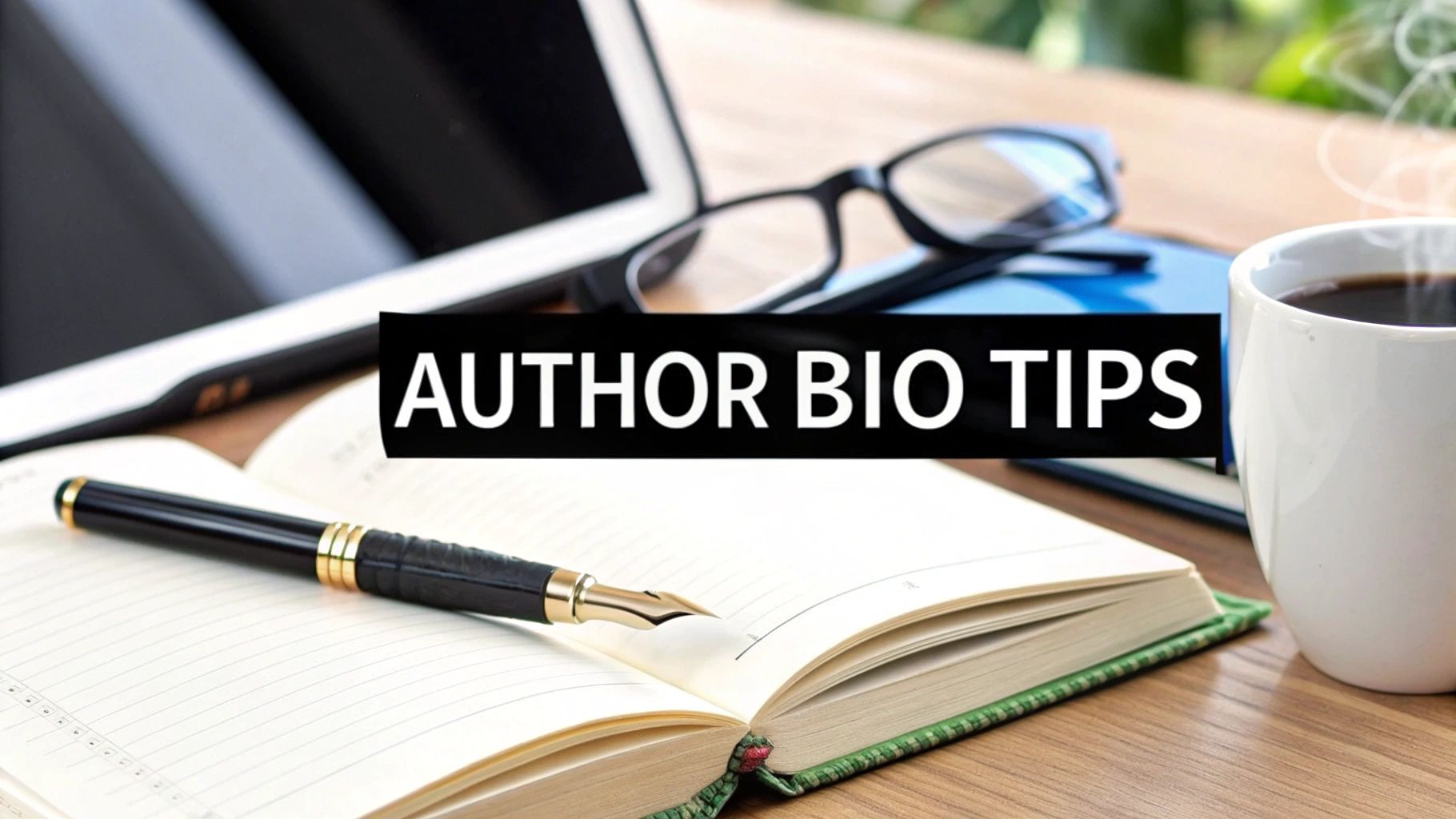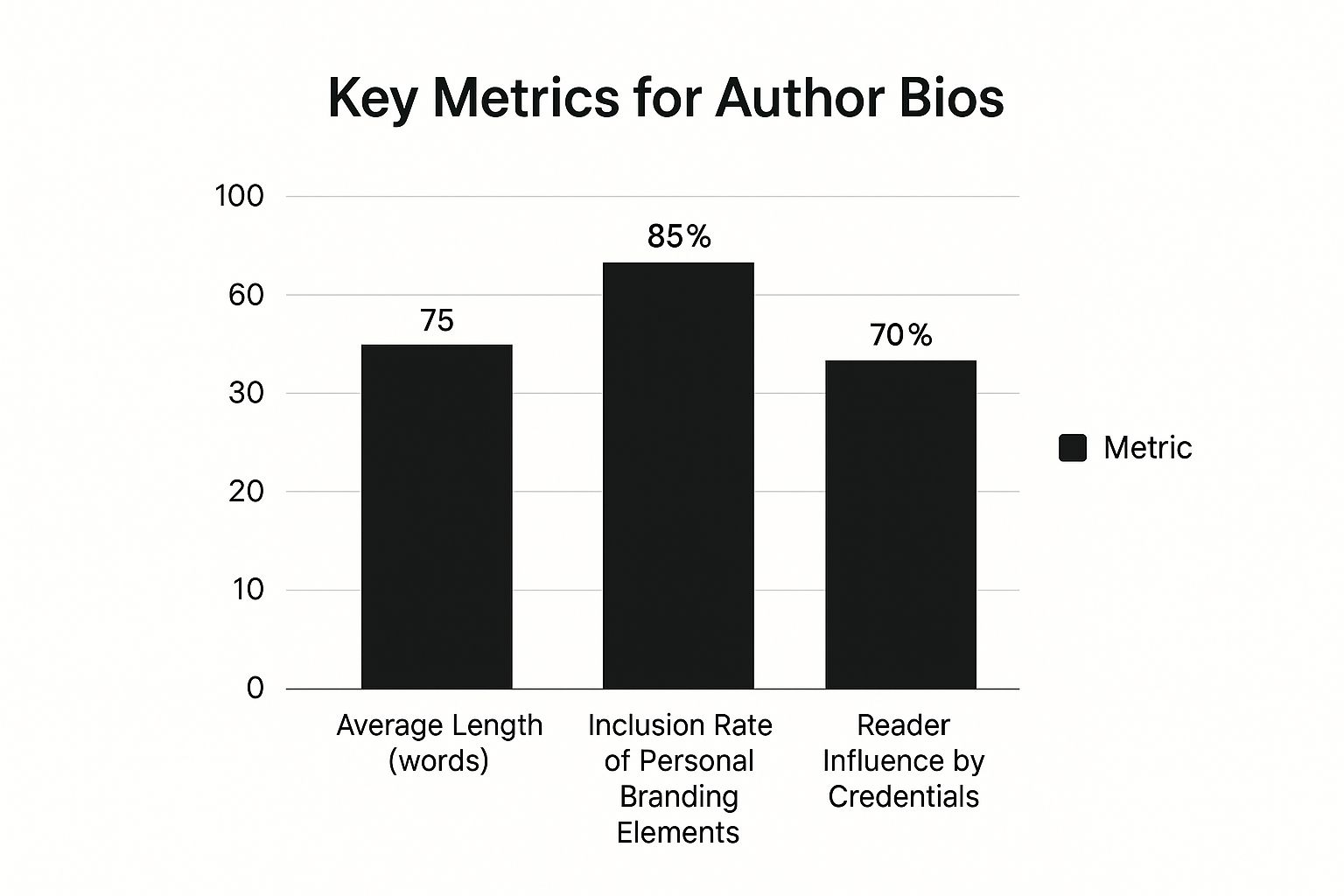
How to Write an Author Bio: Tips to Captivate Readers
Published on 2025-09-24
Think of your author bio as a handshake. It's that first, brief introduction where you mix your professional achievements with a bit of personality to connect with readers. It’s a short, third-person story that needs to showcase your expertise, name-drop your best work, and offer a peek behind the curtain—all while speaking directly to the right audience for your genre.
Why Your Author Bio Is a Powerful Marketing Tool

Let’s be real. Your author bio is so much more than a few lines on a book jacket or your website's "About" page. It’s a critical piece of your marketing toolkit, working hard to build trust and forge a connection before someone even reads the first page.
A well-written bio pulls triple duty. It establishes your credibility, sets the right expectations for your writing, and makes you more approachable. It’s often the final nudge that turns a casual browser into a committed reader.
Building Trust Through Authenticity
This one little piece of content does some heavy lifting. It shows up on your book cover, website, social media, and guest post bylines, constantly reinforcing your author brand. It answers the silent question every reader has: "Why should I trust this person to tell this story?"
A well-crafted bio isn't just a summary of credentials; it's a strategic tool for building a relationship with your audience. It bridges the gap between the author as a name on a cover and the author as a person worth knowing.
In fact, research shows that when a bio directly links the author’s expertise or personal story to the book's subject, reader trust and engagement can jump by up to 40%. It’s compelling proof that you need to show readers why you’re the perfect person to have written this book, not just tell them.
If you’re looking to take this further, learning how to build an online presence is the logical next step. Your bio is the cornerstone of that effort—a compact, powerful tool that reinforces your identity everywhere it appears.
Gathering Your Essential Bio Ingredients

Before you even think about writing a single word of your bio, you’ve got to collect your raw materials. I like to think of this as building a "brag file"—a master list of your accomplishments, quirks, and stories.
Doing this prep work upfront is a game-changer. It means you won't have to start from scratch every time you need a new version of your bio for a different audience. Just pull from your file.
Start by just getting everything down on paper. Don't worry about filtering or judging anything yet. Just brainstorm all the details that make you, you.
Create Your Professional Inventory
Let's start with the facts. This is where you list your credentials, achievements, and all the things that build your authority. These details prove to your readers that you know your stuff.
Jot down everything you can think of:
- Relevant Education and Certifications: Stick to what connects to your writing topic.
- Awards and Recognitions: Don't be shy! List any awards you've received, big or small.
- Previous Publications: Have you written other books, articles, or even guest posts? Include them.
- Professional Roles: Any jobs or experiences that give you credibility are gold.
Listing these facts isn't just about boosting your confidence. Research on bestselling books has shown that bios with quantifiable achievements, like awards or key positions, often lead to higher credibility and more book sales.
Think of this as creating a "master file" of your accomplishments. Later, you can cherry-pick the most relevant details for any specific bio you need, saving you a ton of time and mental energy.
Uncover Your Personal Story
Okay, now for the fun part. It's time to dig into the personal details that show off your personality. This is how you stop sounding like a resume and start sounding like a real person your readers want to connect with.
Consider adding a few of these:
- Hobbies or Passions: What do you love? Urban gardening? Vintage sci-fi movies?
- A Fun or Quirky Fact: Something that makes you memorable and stand out.
- Your Location: Sometimes just mentioning where you live can create a connection.
This blend of professional and personal is the core of any good biography. If you want to dive deeper into this concept, our guide on what a professional biography is explains how it helps build your personal brand.
Ultimately, the secret to a bio that really works is mixing your impressive achievements with a dash of your unique personality. That’s what grabs—and holds—a reader's attention.
Finding the Right Voice for Your Genre
Think of your author bio as a handshake with your reader. A bio for a gritty thriller novel should feel completely different from one for a children's picture book. Your tone of voice acts as a crucial bridge, giving readers a taste of what to expect from your writing.
One of the first decisions you'll make is whether to write in the first person ("I am an author…") or third person ("Jane Doe is an author…"). While there's no single right answer, third person is the industry standard for book jackets, press releases, and formal pitches. It just has a more professional, authoritative feel. First person, on the other hand, is fantastic for your personal website, blog, or social media. It creates a direct, conversational connection that helps build a community around your work.
Matching Your Tone to Your Audience
The real goal here is to make your bio feel like a natural extension of your books. If you write laugh-out-loud humorous essays, a dry, academic bio would feel completely out of place. On the flip side, if your work is dense historical nonfiction, an overly quirky bio might make readers question your credibility.
You want to give your readers a consistent experience. Here are a few ideas to get you started:
- For Thriller/Mystery Authors: A direct, even mysterious, tone works wonders. You could hint at your fascination with the darker side of human nature or what draws you to complex puzzles.
- For Romance Authors: Aim for warmth and charm. Your voice should feel relatable, helping readers connect with the heart and emotion you pour into your stories.
- For Non-Fiction/Academic Authors: Your bio needs to establish trust. An authoritative, clear, and credential-focused tone is the way to go.
- For Children's Book Authors: Think whimsical, friendly, and approachable. You're talking to parents and kids, so your voice should be inviting and fun.
Getting a feel for this in practice can be a huge help. A great next step is to explore some of the different brand voice examples used by successful creators to see how they pull this off.
To help you visualize this, I've put together a quick guide on how different genres approach their bios.
Author Bio Styles by Genre
This table breaks down the common styles, tones, and key elements you'll want to emphasize depending on what you write.
| Genre | Recommended Style | Key Elements to Emphasize | Example Snippet |
|---|---|---|---|
| Thriller/Mystery | Third-Person, Mysterious | Intrigue, fascination with crime, unique research process | "He spends his nights crafting intricate plots and his days wondering if his neighbors are hiding secrets." |
| Romance | First or Third-Person, Warm | Love for happy endings, personal relationships, relatable hobbies | "When I’m not writing about soulmates, you can find me trying to keep my houseplants alive." |
| Sci-Fi/Fantasy | Third-Person, Imaginative | World-building passion, nerdy interests, unique inspirations | "Her stories are born from a lifelong obsession with forgotten myths and future technologies." |
| Non-Fiction | Third-Person, Authoritative | Credentials, professional experience, research, mission/purpose | "With 15 years of experience in marine biology, she is a leading expert on deep-sea ecosystems." |
| Children's Lit | First-Person, Whimsical | Love for storytelling, connection to kids, fun personal facts | "I believe in the magic of a good story, silly rhymes, and the occasional talking squirrel." |
As you can see, the core information might be similar, but the flavor changes completely based on the audience.
Weaving Personality into Your Professional Bio
While matching your genre is important, your bio will fall flat if your personality doesn't come through. It's not just a resume; it's a micro-story about you. You need to hint at your passions, your unique perspective, and what makes you the only person who could have written your book.
This isn’t just a nice idea—it’s what works. The data shows a clear trend toward creative, narrative-driven bios that feel more like a story than a list of facts.

As the chart shows, 92% of effective bios include personal branding elements. People connect with people, not just with credentials. That human touch is what creates an emotional hook that facts alone simply can't provide.
Bringing Your Author Bio to Life

Okay, you've done the prep work. You know your audience, you've gathered your facts, and you have a clear voice in mind. Now it’s time to actually put pen to paper (or fingers to keyboard) and build this thing.
Think of it less like filling out a form and more like telling a micro-story. Every word counts.
You absolutely have to lead with your strongest credential. Your first sentence is your hook, and it needs to immediately tell the reader who you are and why they should give you their time.
For instance, skip the part about where you went to college. Instead, open with something like: "Jane Doe writes gripping historical fiction that unearths the forgotten stories of women in World War II." See? It’s direct, it’s interesting, and it establishes your niche instantly.
Weaving Your Story Together
Once that powerful opening is in place, you can start layering in your other details. The trick is to make it flow like a conversation, not just a bulleted list of your accomplishments.
- Frame Your Accomplishments: Don't just state that you won an award. Give it context. "Her debut novel, The Last Letter, earned her the Historical Fiction Society's New Author Award." It feels more natural and less like bragging.
- Prove Your Expertise: Instead of saying you're an "expert," show it. If you write crime thrillers, mentioning you spent a decade as a forensic scientist gives you instant, undeniable credibility.
- Drop in a Humanizing Detail: A single, relatable tidbit can do wonders. Mentioning your rescue dog or your love for terrible B-movies adds warmth and makes you feel like a real person, not just a name on a cover.
A great author bio answers two critical questions for the reader: "Is this author credible?" and "Is this someone I'd like to get to know?" It's that blend of professional and personal that truly connects.
Think of this as creating your "master bio." You'll tweak and shorten it for different platforms later. For a deeper dive into this, check out a step-by-step guide to creating an engaging professional bio for some more great perspectives.
First-Person vs. Third-Person: Making the Call
One of the biggest questions is whether to write in the first person ("I am...") or the third person ("She is..."). There's a time and place for both.
The third-person perspective is the industry standard. It's what you'll see on book jackets, in press releases, and in formal media kits. It just sounds more official and authoritative.
The first-person approach, on the other hand, is perfect for your personal website, blog, or social media. It feels like you're talking directly to the reader, creating a more immediate and friendly connection.
A seasoned author knows how to switch between these two effortlessly depending on the situation. Get comfortable with both, and you'll have a polished, authentic, and compelling bio ready for any occasion.
Adapting Your Bio for Different Platforms
Think of your author bio less as a static document and more like a chameleon. The bio that works perfectly on your book jacket is going to feel out of place on your punchy, character-limited social media profile. They each have a different job to do.
My best advice? Create a "master bio" document. This is your comprehensive, all-the-details version. From there, you can easily pull, trim, and rephrase for any situation that comes up. The trick is to adjust the length, the tone, and what you're asking the reader to do next based on where they're reading it.
Making It Fit: Brevity and Impact
On social media, you have seconds to make an impression. A platform like Twitter gives you a tiny 160 characters to work with, while Instagram offers a bit more breathing room. You have to make every word count.
Here’s how I think about breaking it down:
Book Jacket Bio (50–100 words): This is where you sound polished and authoritative. You want to hit your most impressive credits and connect your expertise directly to the book they're holding in their hands.
Social Media Bio (25–50 words): Keep it conversational. This is a great place for genre-specific keywords and a single, clear call to action, like a link to your latest release or newsletter sign-up.
Guest Post Byline (25–75 words): Your goal here is to quickly establish why you're the right person to talk about this topic. Then, gently guide interested readers back to your home base—your website, blog, or another platform.
When it comes to your social profiles, a "link in bio" service is a must for directing followers to all your important stuff. If you're weighing your options, this ultimate bio link comparison breaks down some of the most popular choices.
The real goal is consistency in your brand, not in your exact wording. Each bio should still sound like you, even as the details shift to fit the room.
By strategically tweaking your bio for each platform, you make sure you're always connecting with the right readers, wherever they happen to find you.
Got Questions About Your Author Bio? Let's Clear Them Up.
Even after you've got the basics down, a few tricky questions always seem to come up when you're trying to write a great author bio. I've seen writers get stuck on these same points time and time again, so let's walk through them.
Should I Write in First or Third Person?
This is easily the most common question I get. The "I write..." versus "She writes..." dilemma is a classic. The truth is, you don't have to choose just one. The smartest move is to have both versions on hand.
Think of it like having different outfits for different occasions. You'll want to use the third-person bio for more formal situations—think book jackets, official press releases, or speaker introductions at an event. It gives you that professional, "expert in the room" feel.
The first-person bio is for your more personal spaces. It’s perfect for your website's "About Me" page, social media bios, or the bottom of a blog post. This version feels like you're speaking directly to your reader, which helps build a genuine connection.
My rule of thumb is simple: Third person is for when other people are talking about you. First person is for when you're talking to your audience.
How Long Should My Bio Be?
There’s no magic word count. The "right" length for your author bio completely depends on where it's going to live. You need a few different sizes ready to go.
- The Twitter-Sized Bio (Under 160 characters): This is your elevator pitch. It has to be punchy, powerful, and fit into a tiny space.
- The Go-To Bio (50–100 words): This is your workhorse. It’s the one you’ll use most often for things like guest post bylines, conference programs, and the back of most books.
- The Full Story (150–250 words): This longer version is for places where you have more room to stretch out, like your author website or your Amazon Author Central page.
What are the Biggest Mistakes to Avoid?
Finally, let's talk about what not to do. I see a few common missteps that can really weaken an otherwise solid bio.
First, don't just list your accomplishments like a resume. Weave them into a story that tells us who you are. Another big one is forgetting a call to action. Always tell the reader what to do next, whether it's visiting your website or signing up for your newsletter.
And perhaps most importantly, don't let it get stale! Your bio is a living document. Make sure you update it whenever you have a new book, award, or exciting project to share.
Ready to stop staring at a blank page? autoghostwriter uses powerful AI to help you create compelling LinkedIn content that builds your professional brand. Get started for free today